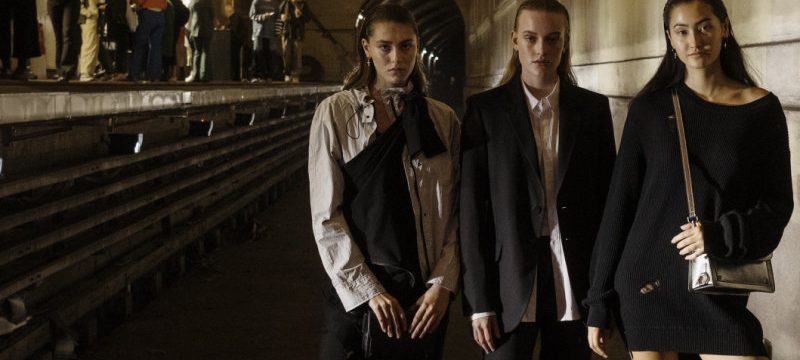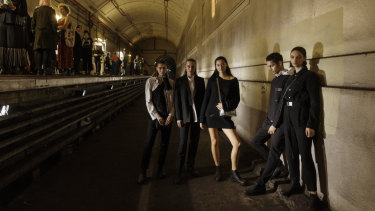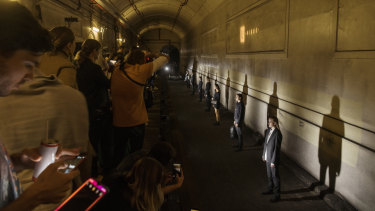At the conclusion of last year's European spring/summer shows, Vogue critic Anders Christian Madsen opined that 2019 could spell the end of gendered fashion as we know it.
"The feeling for ‘genderless’ fashion has never been stronger than it is now," Madsen wrote last October.
Models wearing the genderless collection by Nique at Sydney’s St James Station.Credit:James Brickwood
And on Tuesday, in a disused railway tunnel under Sydney's St James Station, Australian label Nique took a step – or a fast train – towards Madsen's prophecy.
Nique's genderless capsule, dubbed "U", includes suiting, separates and casual pieces that are gender-neutral.
"I was really inspired by our staff and customers. They come in and shop our store as if there are no boundaries," says creative director Nadia Jones. "There's a wider movement happening, people want … a freer lifestyle."
Jones said that despite customers' pre-existing habits and the brand's monochromatic, androgynous-leaning aesthetic, she still wanted to put a stamp on a dedicated genderless range.
She said male customers who liked some women's styles would often struggle to fit in the store's size range, while the opposite was true for women – many of the men's size smalls were too large.
Creating a genderless range of casual wear is one thing but, as Jones explained, tailoring is where things get more challenging.
"We tried lots of different fits, it was a big learning curve. The way men's pants fit women – men have straighter bodies – but they fit quite tightly for a more sexy [look]."
Jones said she wanted the range to be authentic, meaning there were no skirts or dresses just for "shock value".
The Nique catwalk took place in the disused tunnel under St James Station.Credit:James Brickwood
"We didn't really want to go for show-stopping headlines that really don't mean anything," she said.
Genderless fashion has been one of the big global fashion trends of the past 12 months, backed up by the growing number of international luxury brands, such as Gucci and Burberry, that show their men's and women's collections on the same runway, often putting male models in "female" styles and vice-versa.
Designers such as Dior's Kim Jones are also blurring traditional definitions of menswear by incorporating softer suiting and more colour into their men's ranges, while at the same time women's tailoring has embraced oversized silhouettes. So, in a sense, they are meeting somewhere in the middle.
More formally, there has been a spate of womenswear brands, including Celine and The Row, expanding into menswear. In Australia, we have also seen this in the reverse, with tailoring brand P Johnson, which this week is launching its PJ Femme line of womenswear.
Menswear retailers are seeing more women shopping for themselves, something that is backed up to some degree by in-store and online customer data.
"To encourage women to buy menswear is a good thing, not only for their boyfriends but to share it with their boyfriends," says Jones, adding that womenswear accounts for about 70 per cent of their business.
And although men buying womenswear isn't as common, Aje co-creative director Edwina Forest has said more men are buying the brand's signature logo tees, while unisex stores such as Jac & Jack also report more fluidity across the shop floor. Other brands, such as ABC.H, are moving away from selling on gendered lines by dispensing with "men's" and "women's" sections of their stores and websites.
Source: Read Full Article


